Graph Neural Networks - Notes
Nihal V. Nayak
March 2020
1
Introduction
Graph Neural Networks (GNN) is a type of neural network which learns the
structure of a graph. Learning graph structure allows us to represent the nodes
of the graph in the euclidean space which can be useful for several downstream
machine learning tasks. Recent work on GNN has shown impressive perfor-
mance on link prediction, graph classification and semi-supervised tasks (Hamil-
ton et al., 2017b). Since there is a growing interest in the machine learning
community to learn more about these techniques, this document provides an
introduction to GNN1.
The document is organized as follows: First, we introduce the basic concepts
of graphs and networks. Second, we describe the major steps used in GNNs to
compute node embeddings. Next, we describe three GNN techniques that are
commonly mentioned in the existing literature. Finally, we include a limited
survey of other notable works in the field.
2 Basics
In this section, we will review the basics of networks that will be useful to
understand the forthcoming sections.
Graphs consist of a set of nodes V and edges E. They are normally repre-
sented with an unweighted adjacency matrix A, which consists of 1s and 0s.
For example, take a look at the graph in figure 1. The graph has 3 nodes
and 2 edges. The adjacency matrix is as follows:
0
1
0
1
0
1
0
1
0
(1)
The degree matrix is a diagonal matrix that contains information about the
degree of each node. The Degree of a node indicates the number of terminating
edges for a node (self-loop counts as 2). For example, the degree matrix for fig.
1 is as follows:
1This document assumes that you are familiar with the basics of deep learning
1
�
1
0
0
0
2
0
0
0
1
Figure 1: Graph with 3 nodes and 2 undirected edges
(2)
In GNN, each node v is associated with a feature vector xv ∈ Rd. Typically,
the feature vector is randomly initialized and trained on a downstream task.
Although we have not introduced graph neural network, it would be useful
to know how to compute the neighbors for a node. For example, from Figure 1
the neighbours of the node b are:
(3)
where N (.) is the neighbour function. Likewise, the neighbor of the node a
N (b) = {a, c}
is:
N (a) = {b}
(4)
As you can see, each node can have a varying number of neighbors. There-
fore, we need a neural network that can deal with the varying number of neigh-
bors.
3 Learning on Graphs
Graph Neural Network learns the structure of the graph such that the node
embedding reflects the structure in the euclidean space (Hamilton et al., 2017b).
A basic GNN layer consists of two steps:
• AGGREGATE: For a given node, the AGGREGATE step applies a per-
mutation invariant function to its neighbors to generate the aggregated
node feature
• COMBINE: For a given node, COMBINE step passes the aggregated node
feature to a learnable layer to generate node embedding for the GNN layer
The GNN layers are stacked together to increase the receptive field of clus-
tering. For example, in Fig. 2 we have 2 GNN layers. This means that for every
node, we aggregate over the 2-hop neighborhood.
2
�
Figure 2: Left: 2 GNN layers stacked together and Right: shows the how the
node feature is generated for a node (green) in a 2 layer GNN. The node (green)
learns the node embedding by aggregating over 2-hop neighbourhood.
AGGREGATE and COMBINE steps are sometimes called message passing
phase and readout phase in the message passing neural network framework
(Gilmer et al., 2017).
3.1 Formal Definition
Consider the Graph G = (V, E), where V is the set of node with features Xv.
There are two main steps - AGGREGATE and COMBINE at each l-th layer of
the GNN:
where a(l)
v
is the aggregated node feature of the neighbourhood, h(l−1)
u
node feature in neighbourhood N (.) of node v.
(5)
is the
(6)
a(l)
v = AGGREGATE(l)
v = COMBINE(l)
h(l)
h(l−1)
u
∀u ∈ N (v)
h(l−1)
v
, a(l)
v
where h(l)
v
is the node representation at the l-th iteration. h(0)
v = xv where
xv is the initial feature vector for the node.
4 Graph Convolutional Networks (GCN)
GCN (Kipf and Welling, 2016) is a graph neural network technique that makes
use of the symmetrically normalized graph laplacian2 to compute the node em-
beddings. Each GCN block receives node features from the (l−1)th GCN block,
i.e. the node features from the previous layer is passed to the next GCN layer,
which allows for greater laplacian smoothing (Li et al., 2018).
2Refer to A for more details on Graph Laplacian.
3
�
4.1 Aggregate
Since we don’t always have access to the entire graph structure to compute
the symmetrically normalized graph laplacian, GCN Aggregator has been inter-
preted as a Mean Aggregator (Xu et al., 2018a). Therefore,
, u ∈ N (v) ∪ {v}
a(l)
v = Mean
h(l−1)
u
(7)
For each node v, the algorithm takes the mean of the neighborhood node
features along with its feature (self-loop) to compute the aggregated node feature
a(l)
for the lth layer. This formulation makes GCN an inductive graph neural
v
network.
4.2 Combine
The aggregated node feature a(l)
v
followed by a non-linear activation (ReLU) to get the node feature h(l)
lth layer,
is multiplied with a learnable weight matrix
v for the
h(l)
v = ReLU
W (l)a(l)
v
(8)
where W (l) is the learnable weight matrix.
5 GraphSage
Graphsage (Hamilton et al., 2017a) is a spatial graph neural network algorithm
that learns node embeddings by sampling and aggregating neighbors from mul-
tiple hops. Graphsage, unlike GCN, is an inductive learning algorithm which
means that it does not require the entire graph structure during learning.
In the original Graphsage paper, the authors describe multiple aggregators
- Mean, Pooling and LSTM Aggregator. In this section, we’ll be describing the
Pool Aggregator and the combine from the original paper. For simplicity, we
do not sample the neighborhood nodes as well.
5.1 Aggregate
Graphsage makes use of a max-pooling aggregator to compute an aggregated
node feature. All the neighborhood node features are passed through a lin-
ear layer. We then pass these features through a non-linear activation before
applying max filter. Formally,
W (l−1)
pool h(l−1)
u
σ
a(l)
v = max
is the aggregated node feature for the lth layer. W (l−1)
+ b
, u ∈ N (v)
(9)
pool and b are
where a(l)
v
the learnable parameters.
4
�
5.2 Combine
The combine function concatenates the (l − 1)th layer node feature h(l−1)
the aggregated feature vector a(l)
neural network:
with
v and pass the vector through a fully connected
v
h(l)
v = ReLU
W (l)[h(l−1)
v
, a(l)
v ]
(10)
where W (l) is a learnable weight matrix for lth layer.
6 Graph Attention Network (GAT)
Graph Attention Network (Veliˇckovi´c et al., 2018) is a spatial graph neural
network technique that uses Self Attention to aggregate the neighborhood node
features. Self Attention is equivalent to computing a weighted mean of the
neighbourhood node features.
The original paper uses K masked self attention modules to aggregate node
features. For simplicity, we consider only one self attention block.
6.1 Aggregate
GAT uses an Attention module to compute the weighted mean of the neighbor-
hood node features as follows:
, u ∈ N (v) ∪ {v}
a(l)
v = Attention
h(l−1)
u
(11)
The authors use self-attention (Bahdanau et al., 2014) but the aggregation
technique is agnostic to the choice attention mechanism.
6.2 Combine
The aggregated node feature a(l)
v
followed by a non-linear activation to get the node feature h(l)
is multiplied with a learnable weight matrix
v for the lth layer,
h(l)
v = LeakyReLU
W (l)a(l)
v
(12)
where W (l) is the learnable weight matrix.
7 Related Works
Apart from GCN, Graphsage, and GAT, there are few more works that fre-
quently appear in the literature. SGN (Wu et al., 2019) simplifies GCN by
removing non-linearity between the GCN layers. Furthermore, to achieve the
same “receptive field” of having K GCN layers, they take the graph laplacian
to the power of K and show equivalent performance. Xu et al. (2018b) intro-
duced jumping knowledge networks that aggregate node features generated from
5
�
all the previous layers to compute the final vector using mean or max-pooling.
This allows the model to learn better structure-aware representations from dif-
ferent neighborhood aggregations. The works described so far have not taken
advantage of the relations in the graph. R-GCN (Schlichtkrull et al., 2018)
and Directed-GCN (Marcheggiani and Titov, 2017) extend GCN to relational
graphs.
References
Bahdanau, D., Cho, K., and Bengio, Y. (2014). Neural machine translation by
jointly learning to align and translate. arXiv preprint arXiv:1409.0473.
Gilmer, J., Schoenholz, S. S., Riley, P. F., Vinyals, O., and Dahl, G. E. (2017).
Neural message passing for quantum chemistry. In Proceedings of the 34th
International Conference on Machine Learning-Volume 70, pages 1263–1272.
JMLR. org.
Hamilton, W., Ying, Z., and Leskovec, J. (2017a).
Inductive representation
learning on large graphs. In Advances in Neural Information Processing Sys-
tems, pages 1024–1034.
Hamilton, W. L., Ying, R., and Leskovec, J. (2017b). Representation learning
on graphs: Methods and applications. IEEE Data Eng. Bull., 40:52–74.
Kipf, T. N. and Welling, M. (2016). Semi-supervised classification with graph
convolutional networks.
Li, Q., Han, Z., and Wu, X.-M. (2018). Deeper insights into graph convolutional
networks for semi-supervised learning. In Thirty-Second AAAI Conference on
Artificial Intelligence.
Marcheggiani, D. and Titov, I. (2017). Encoding sentences with graph convolu-
tional networks for semantic role labeling. arXiv preprint arXiv:1703.04826.
Schlichtkrull, M., Kipf, T. N., Bloem, P., Van Den Berg, R., Titov, I., and
Welling, M. (2018). Modeling relational data with graph convolutional net-
works. In European Semantic Web Conference, pages 593–607. Springer.
Veliˇckovi´c, P., Cucurull, G., Casanova, A., Romero, A., Li`o, P., and Bengio,
Y. (2018). Graph Attention Networks. International Conference on Learning
Representations.
Wu, F., Souza, A., Zhang, T., Fifty, C., Yu, T., and Weinberger, K. (2019).
In International Conference on
Simplifying graph convolutional networks.
Machine Learning, pages 6861–6871.
Xu, K., Hu, W., Leskovec, J., and Jegelka, S. (2018a). How powerful are graph
neural networks?
6
�
Xu, K., Li, C., Tian, Y., Sonobe, T., Kawarabayashi, K.-i., and Jegelka, S.
(2018b). Representation learning on graphs with jumping knowledge net-
works. arXiv preprint arXiv:1806.03536.
A Graph Laplacian
The adjacency matrix and degree matrix can be combined to get the Graph
Laplacian (commonly occurs in the literature).
L = D − A
(13)
where L is the graph laplacian, D is the degree matrix and A is the adjacency
matrix.
The symmetric normalized graph laplacian can be formally defined as:
Lsym = D− 1
2 LD− 1
2 = I − D− 1
2 AD− 1
2
where I is the Identity matrix.
The elements of Lsym are given by:
Lij =
deg(vi)deg(vj)
1
1
−
0
if i == j and deg(vi) = 0
if i = j
otherwise
(14)
(15)
(16)
B Original GCN
In section 4, we interpreted GCN (Kipf and Welling, 2016) as a mean aggregator.
However, there is a subtle difference between our interpretation and the original
GCN.
Consider the adjacency matrix A and its degree matrix D. Let H (l) be the
node features for the lth layer and H (0) = X. The propagation rule for each
GCN layer is as follows:
˜D− 1
2 H (l)W (l)
f (H (l), ˜A) = σ
2 ˜A ˜D− 1
with ˜A = I + A where I is the identity matrix and degree matrix ˜D of ˜A.
7
�
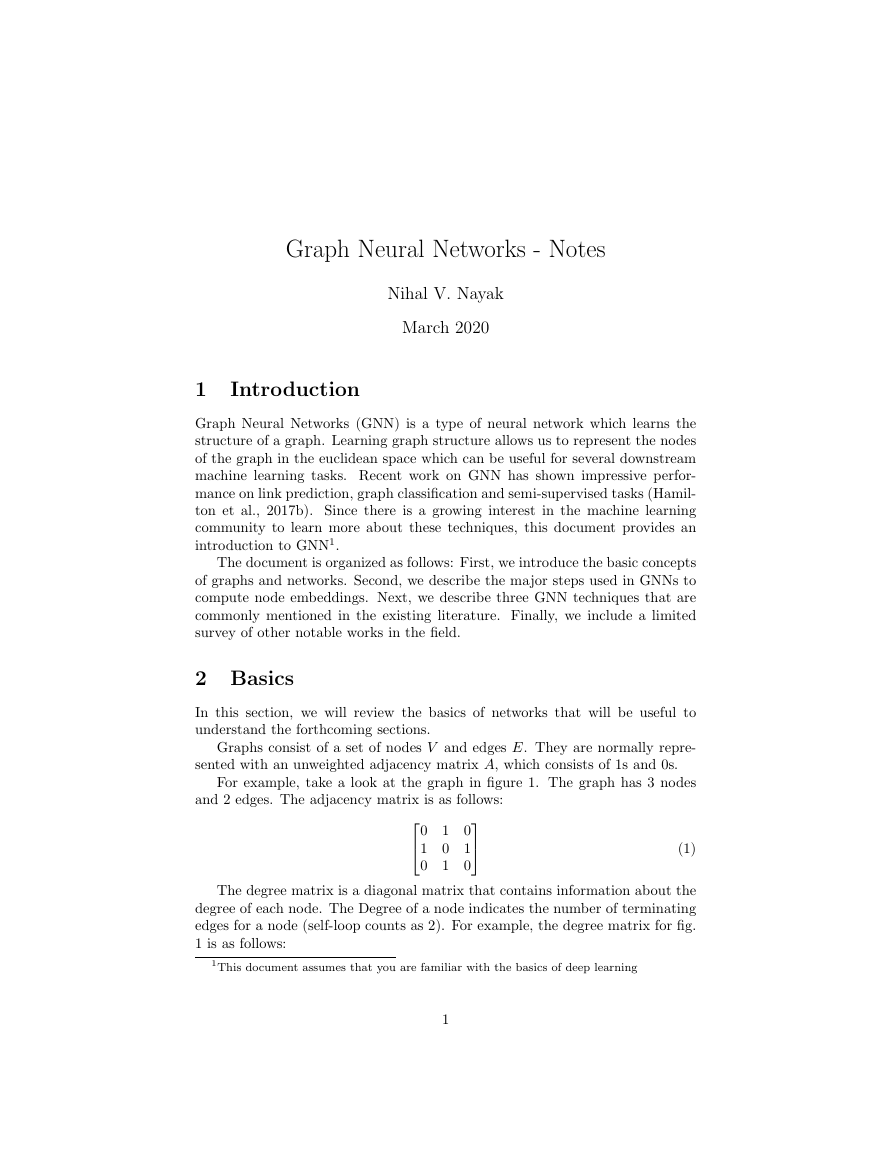

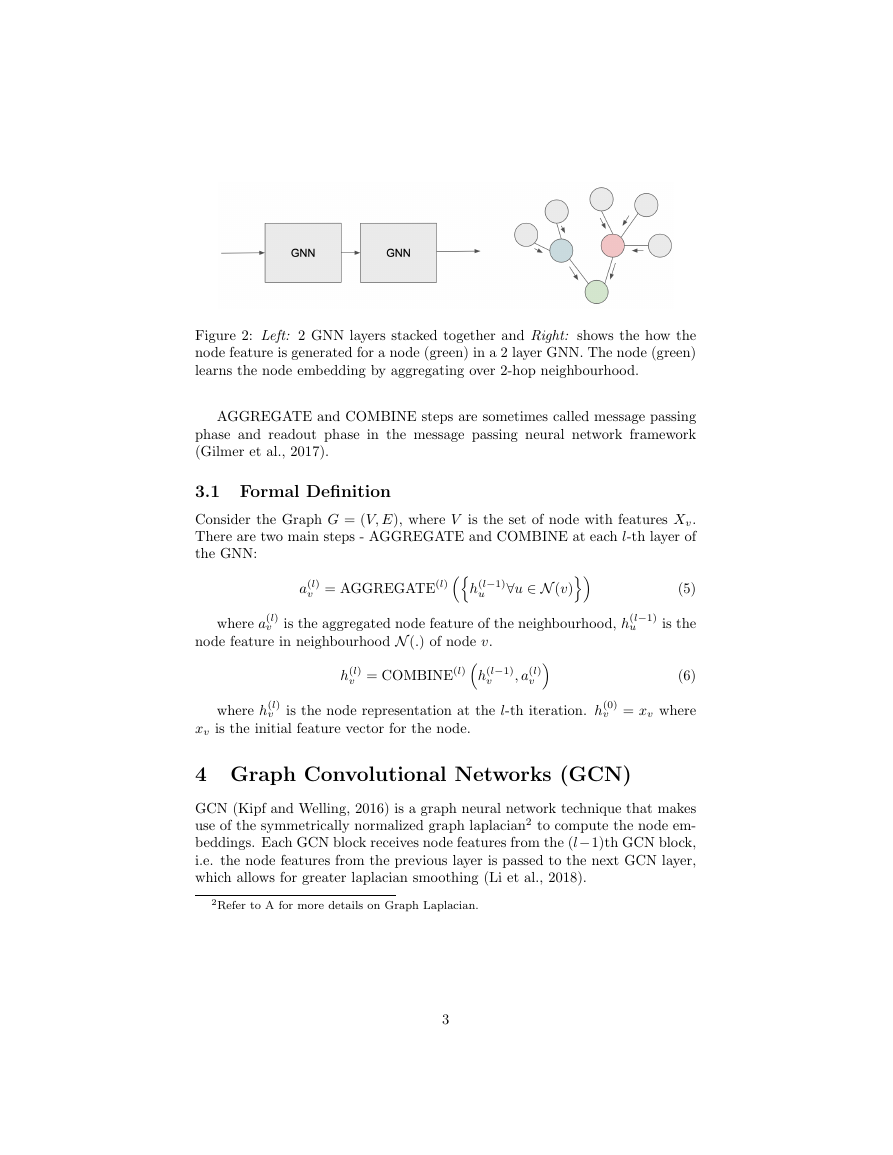
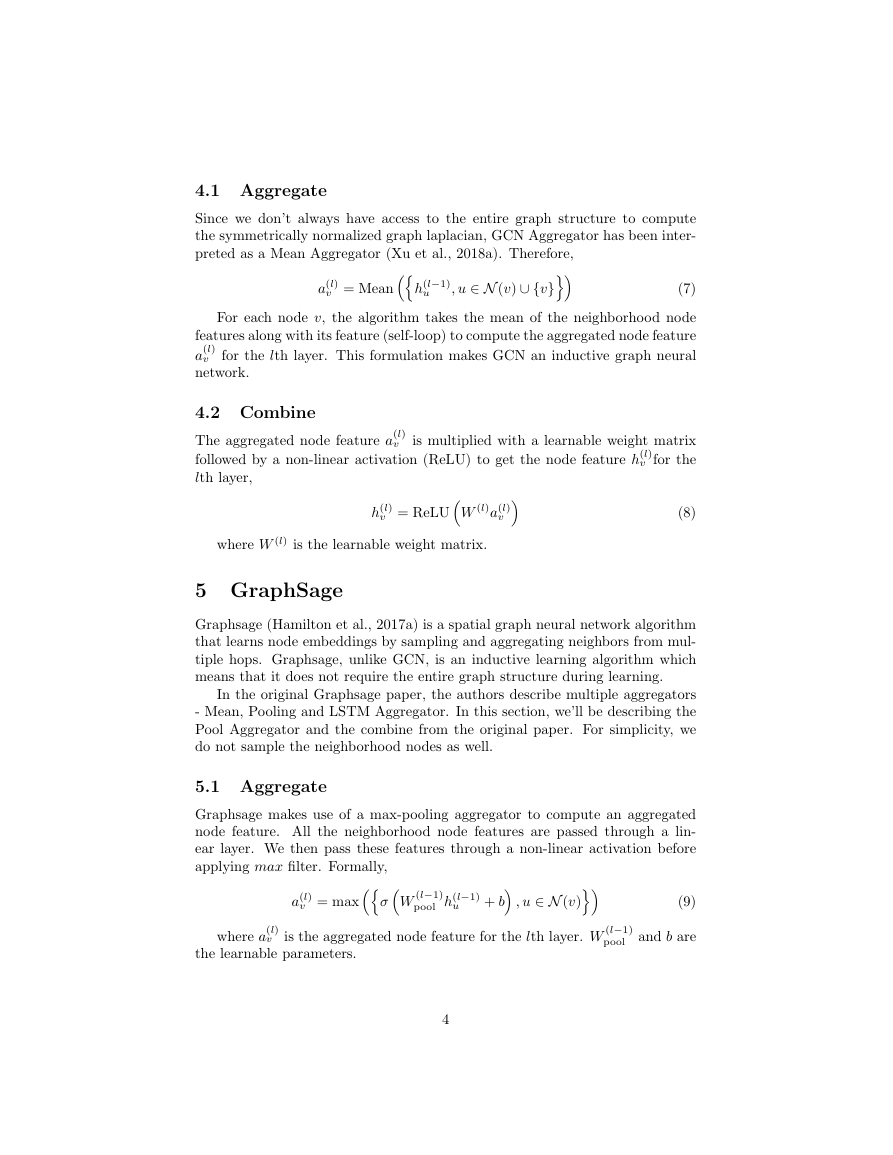
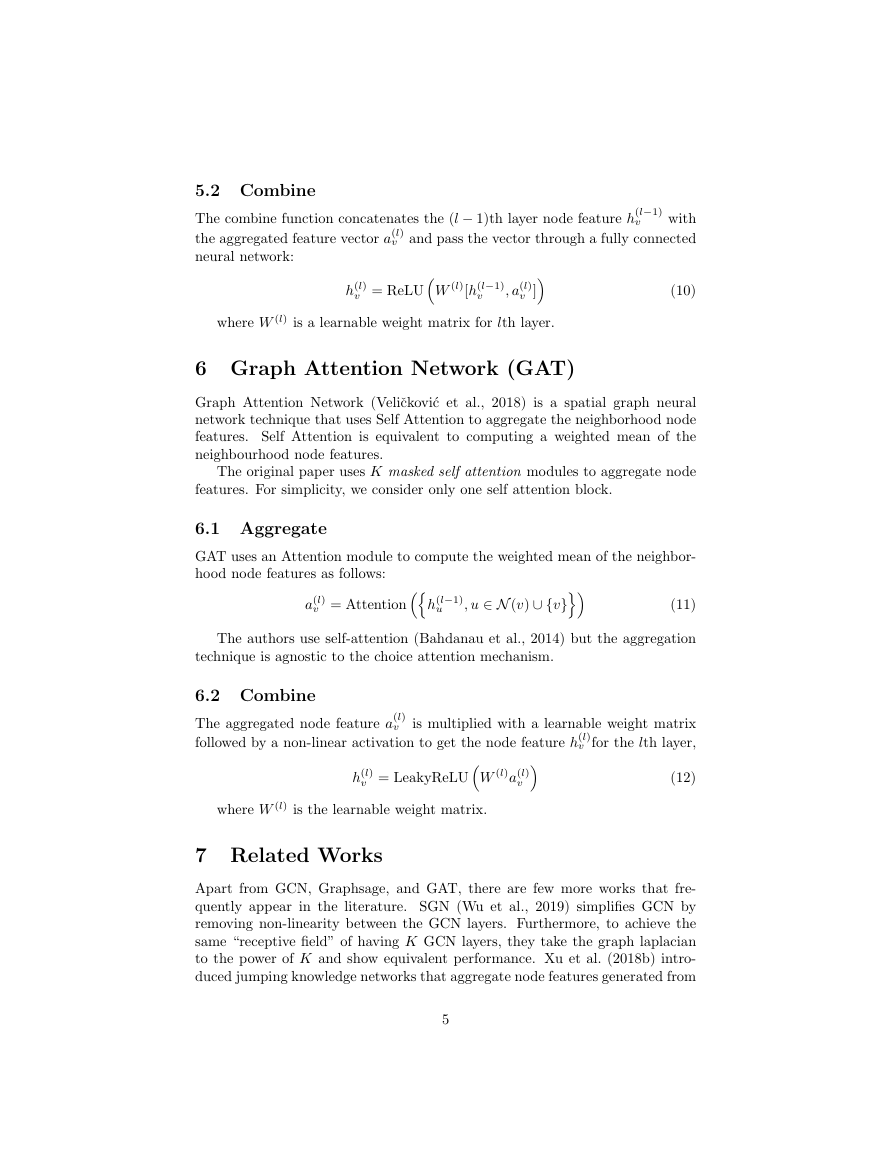
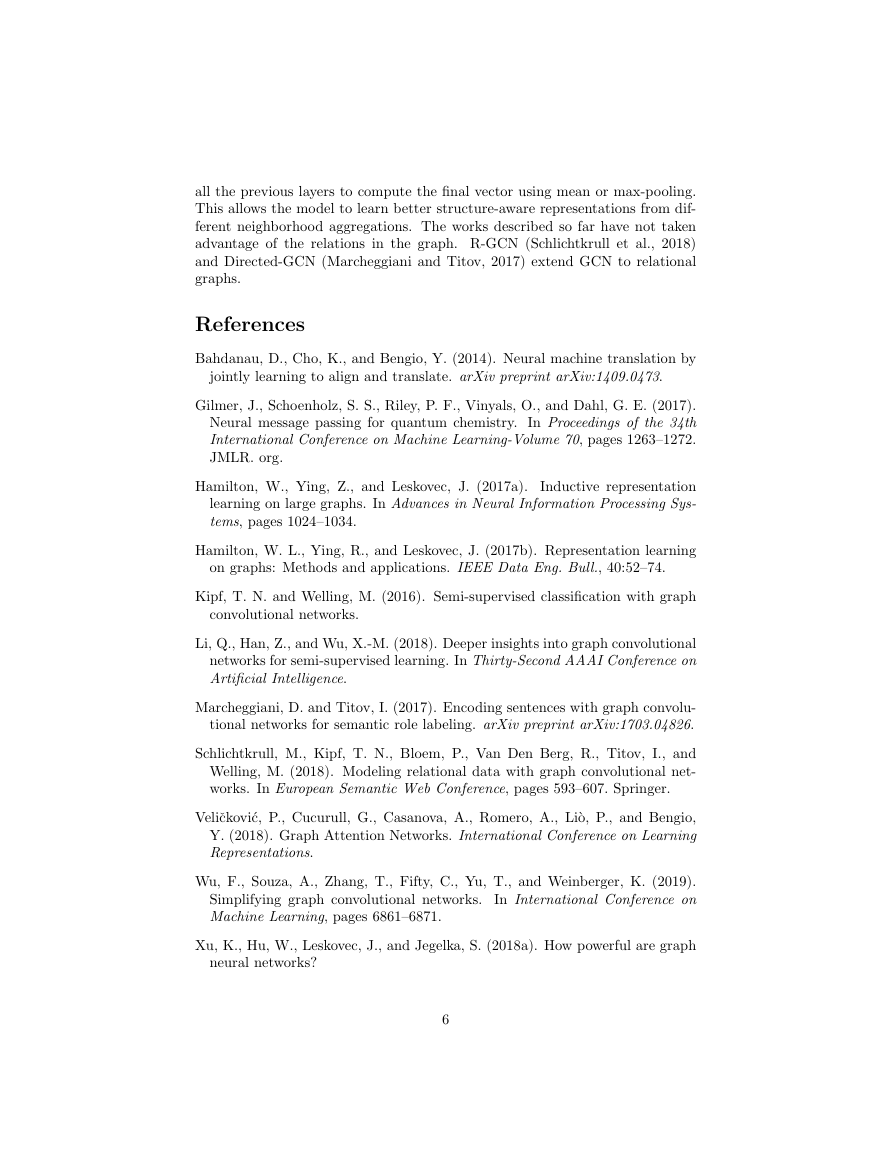








 2023年江西萍乡中考道德与法治真题及答案.doc
2023年江西萍乡中考道德与法治真题及答案.doc 2012年重庆南川中考生物真题及答案.doc
2012年重庆南川中考生物真题及答案.doc 2013年江西师范大学地理学综合及文艺理论基础考研真题.doc
2013年江西师范大学地理学综合及文艺理论基础考研真题.doc 2020年四川甘孜小升初语文真题及答案I卷.doc
2020年四川甘孜小升初语文真题及答案I卷.doc 2020年注册岩土工程师专业基础考试真题及答案.doc
2020年注册岩土工程师专业基础考试真题及答案.doc 2023-2024学年福建省厦门市九年级上学期数学月考试题及答案.doc
2023-2024学年福建省厦门市九年级上学期数学月考试题及答案.doc 2021-2022学年辽宁省沈阳市大东区九年级上学期语文期末试题及答案.doc
2021-2022学年辽宁省沈阳市大东区九年级上学期语文期末试题及答案.doc 2022-2023学年北京东城区初三第一学期物理期末试卷及答案.doc
2022-2023学年北京东城区初三第一学期物理期末试卷及答案.doc 2018上半年江西教师资格初中地理学科知识与教学能力真题及答案.doc
2018上半年江西教师资格初中地理学科知识与教学能力真题及答案.doc 2012年河北国家公务员申论考试真题及答案-省级.doc
2012年河北国家公务员申论考试真题及答案-省级.doc 2020-2021学年江苏省扬州市江都区邵樊片九年级上学期数学第一次质量检测试题及答案.doc
2020-2021学年江苏省扬州市江都区邵樊片九年级上学期数学第一次质量检测试题及答案.doc 2022下半年黑龙江教师资格证中学综合素质真题及答案.doc
2022下半年黑龙江教师资格证中学综合素质真题及答案.doc